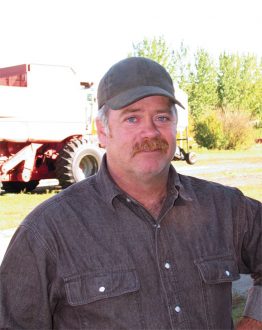Speed one factor in lower harvest losses
Rob Gulden and Andrea Cavalieri’s report, “Evaluation of the causes of on-farm harvest losses in canola in the Northern Great Plains,” was published in Crop Science 2016 Vol 56
Teketel Haile’s report, “On-farm seed loss does not differ between windrowed and direct-harvested canola,” was published in Canadian Journal of Plant Science 2014 Vol 94

Brent Lensen combines canola at no more than three miles per hour, and it seems to work for him and his Case IH rotary. The farmer from Vanscoy, Sask., participated in a canola harvest loss survey in 2010 and his results were better than average.
“Lensen’s losses were small compared to the average yield loss reported from all fields,” says Teketel Haile, the University of Saskatchewan researcher who helped with a harvest loss study by Rob Gulden and Andrea Cavalieri at the University of Manitoba. The survey measured harvest losses for 310 fields in four regions from 2010 to 2012.
Haile literally vacuumed up all loose material from six quarter-square-metre “quadrats” at three locations in each field. “It took a long time to separate shattered seeds from dirt, weed seeds and chaff,” he says.
Lensen had two fields measured for harvest losses in 2010. Field one yielded 32 bu./ac. with an average loss of 0.8 bu./ac., or 2.4 per cent. Field two yielded 29 bu./ac. with an average loss of 2.0 bu./ac., or 6.5 per cent. His average loss over both fields was4.4 per cent.Average loss for all 26 Saskatoon region fields surveyed in 2010 was 5.7 per cent.
For the whole study, the lowest average loss was 4.0 per cent for fields around Lacombe, Alta., in 2012 and the highest was 8.5 per cent for the Saskatoon region, also in 2012.
Participating growers also completed a questionnaire to collect agronomic data for each field. Wind data from the nearest local weather station was used to determine wind speed during the harvest season. As Gulden and Cavalieri’s published report noted, “total on-farm harvest losses in canola are a complex phenomenon.”
They concluded that growers can reduce harvest losses with earlier harvest (which is often a result of seeding decisions and conditions), fungicide application at flowering, lower combine ground speed and reduced swather width.
Interestingly, the study found that combine manufacturer and B. napus variety did not contribute significantly to total harvest losses in canola.
Harvest method did not make a difference either. Haile published his own report based on 16 straight combined and 19 swathed canola fields he surveyed over the three years. “There were no differences in seed yield, loss or seedbank addition of canola between windrowing and direct-harvesting operations,” he wrote. “This may suggest that direct-harvesting can be considered a viable option to harvest canola in Western Canada.”
Lensen swaths his canola and when it comes time to combine, he uses a drop pan to check for losses. “We always pay close attention to how we set the combine,” he says. “But while we set it the best we can, losses can occur in the swath or at the header when you pick up the swath.”
Growers have steps they can take to reduce risk – such as combining slower – but the study found that spring conditions preventing rapid and even stand establishment and harvest wind and weather delays are often key factors determining the overall level of canola harvest losses.




